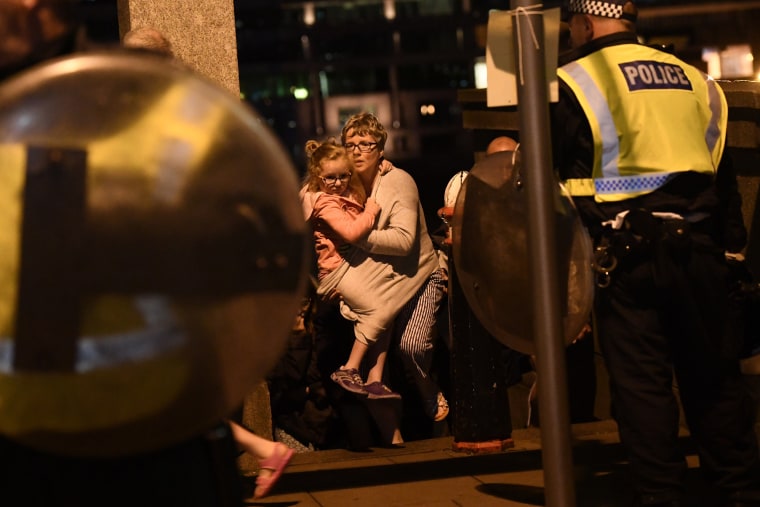LONDON — The attack on London Bridge and nearby Borough Market appear to follow a recent terrorism trend in targeting open areas with less security, as well as groups of visitors and tourists.
A van collided with pedestrians Saturday night before reports of stabbings and shots fired came from the market, an area known for its food stalls, pubs and restaurants.
Authorities are calling Saturday's incidents acts of terrorism, and they come less than two weeks after a bomber targeted concertgoers leaving an Ariana Grande performance at Britain’s Manchester Arena. In that case, the attacker struck in an area just outside the security perimeter.
The suspect detonated an improvised explosive device near one of the exits, bypassing the auditorium security checks and hitting crowds as they left the event.
“This is a trend that we’ve seen more and more," Michael Leiter, NBC News analyst and former director of the U.S. National Counter-Terrorism Center, told TODAY following the concert suicide bombing. "We saw it in the airport attack in Turkey. We saw it in the airport attack in Brussels."
The Jun. 28, 2016 attack at the Istanbul Ataturk airport killed 45 people at the entrance to a terminal building, while the Mar. 22, 2016 attacks in Brussels included a bomb in an airport check-in area prior to security checks.
“The attackers know where the security perimeter begins, go just outside that, where you still have a crowd, and that’s where the target is softest,” said Leitner.
Security experts call this security conundrum “displacement," in which extending secure areas simply shifts the most vulnerable points.
“There is a pattern in terms of displacement,” said Professor Andrew Silke, the Head of Criminology and Director Terrorism Studies at the University of East London in England. “If you increase security in certain places, you see displacement in others.”
“One of the challenges you have is complete security is impossible; it’s a pipedream. You wouldn’t like it if you had it and you can’t afford it anyway,” Silke added. The best security officials can achieve is trying to “manage risks” and think about the knock-on effects of displacement, he said.
ISIS claimed responsibility for the Manchester attack, but produced no evidence.
Rohit Kachroo, security editor for NBC News' U.K. partner ITV News, reported that nuts and bolts were spotted in the arena's foyer but police would not comment on whether victims had suffered wounds from shrapnel.
Leitner said the bomber must have understood how to make an explosive device powerful enough to kill 22 people and injure over 50.
“The fact is though, today, you don’t need to go to a place like Syria to get that understanding. You can get it on the internet,” said Leitner. “And that’s what makes these attacks so tough to stop.”
The Quilliam Foundation, a London-based counter-extremism group, also said the Manchester attack “fits an unfortunate pattern over the last decade."
In a statement, it said: "Soft targets such as concert halls and nightclubs have been targeted before in Paris, Istanbul, Orlando, and Bali, with the focus not just on inflicting mass casualty, but on attacking a way of life.”

